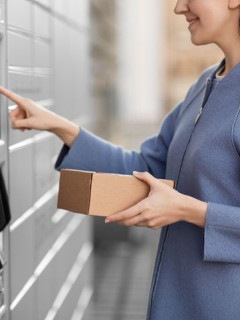Every warehouse must have order and tidiness – so that different items, parcels can be found easily and quickly. For this purpose, a sophisticated labelling, marking, marking system is used. One of the most important markers are the quite universal GS1 logistics labels, used for marking and monitoring the flow of goods. They make it easier for manufacturers, logistics companies and others involved in the transport of goods. What else is worth knowing about carton labelling in the warehouse?
Types of labelling in the warehouse
Orientation in the warehouse is based on signs and information boards, markings on the floor and shelves, as well as labels on cartons and products. The former divide the storage room into different areas. Floor and shelf markings determine where an item needs to be stored. Carton labels, on the other hand, are designed for precise marking and identification of goods (even when they have been misplaced). They belong to the GS1 group of logistics labels, which are also affixed to other logistics units, such as pallets.
Increasingly, electronic shelf labels (ESL, e-link labels), RFID, are appearing in more modern warehouses.
How to label cartons in the warehouse? Ways of labelling cartons
All packages must have information printed on their surface. The barcode of the labels records important messages: article number, expiry date, serial number, ingredients, safety instructions. The labels themselves also contain the price, batch or product number.
The flow of incoming and outgoing goods is recorded and controlled in the goods management system via scanners. Every company that has a warehouse uses different, yet universal, barcodes (1D, 2D, Code 128, Code 39, QR code, EAN) on its packages. For example: Code 128 can be read by all barcode scanners. It appears on shipping labels. EAN code is used to read article and price information from a database (using cash registers).
Do you want to know more? Read: What is a logistics label?
Other signs and labels in the warehouse
The ways to label cartons in warehouses are rather standardised, similar in every warehouse space. Shelving and location labels are examples of labels in the warehouse, linked to shelves and racks. The former contain organisational information resulting from the organisation of work in the warehouse. Each racking label contains aisle numbers, field numbers, SKU codes or the types of goods stored. Location labels are attached either permanently or by means of warehouse label fixing systems, such as self-adhesive pockets, and magnetic pockets or holders. Occasionally, off-the-shelf magnetic labels or C-profile magnetic strips (for inserting cardboard markings) are used.
Location labels and bulk shelf labels have slanted barcodes, which eliminates the risk of misreading when they come into contact with a scanner at work. They also provide a clear and aesthetically pleasing way to locate which shelf, rack or floor the code refers to.
Importantly, the slanted barcodes on the labels not only allow them to be read aesthetically, but also look aesthetically pleasing. Shelf labels and inventory labels complement the shelf labels.
What are the racking labels made of?
Shelving labels are usually manufactured as self-adhesive foil stickers with a lifespan of many years. However, if the entrepreneur wishes, other substrates such as PVC can be used. Racking plates are useful when the racking beam contains deep embossing. Another more modern type of information media are magnetic labels and plates. These are used wherever a change of address is required.
If, for some reason, it is not possible to place collective racking and location labels on a beam in the warehouse, another method can be used: vertical collective labels attached to the racking leg.
How are cardboard labels produced?
You already know the basic principles, materials and ways to label cartons. Are you now wondering what to print the labels on? How are they produced? Logistics labels on cartons are printed using a specialised adhesive label printer – sooner or later, every e-commerce business will have to purchase or rent such a device. You can choose between thermal or thermal transfer printers. The former equipment is easier to use, while the latter requires the purchase of additional consumables. Thermal printers use a good adhesive paper of the chosen format – the standard is 100 x 150 mm. A thermal transfer printer gives better results (with the presence of the desired consumables) – thanks to it, the barcode and other inscriptions on logistics or courier labels will be visible even from a distance. Check out our range of labellers and labelling machines here.
What qualities does the ideal cardboard label have?
Labels should be printed on good quality paper – this is a basic rule. Otherwise, there is a risk that the printed data will smudge. Labels – whether courier or warehouse labels – should be resistant to moisture, abrasion, extreme temperatures, UV radiation, mechanical damage, and external influences.
Printing technology also plays a significant role. The most durable, albeit rather expensive, is thermal transfer.
How do labels affect order in the warehouse?
A high level of tidiness is one of the most important characteristics of a good warehouse. Why and how do you keep your warehouse tidy? By doing so, you can contribute to greater efficiency in logistics and warehouse operations, and you can realistically optimise the working time of all employees on the shop floor. In addition, cleanliness and tidiness promote well-being – the positive energy and good morale of warehousemen and other working people in turn translates into productivity.
Maintaining order in the warehouse (in terms of shelf order) is made possible, among other things, by inconspicuous labels on cartons, shelves, racks, etc. Thanks to them, it is possible to have a real impact on the time it takes to pick goods for parcels, the speed of searching for items on shelves (without the risk of clutter), the speed and efficiency of sorting shipments.
Carton labelling in the warehouse – check out RAJA
The RAJA online shop has focused mainly on a variety of warning labels designed to be applied to parcels. Interested parties can choose between self-adhesive, universal, circular and coloured labels. In warehouse conditions, pallet labels for bulk loads, labels for printing UN codes, self-adhesive label strips and professional label printers (e.g. Zebra thermal printer, Zebra industrial printer) will be ideal.














